The PSAT is key for readying students for college. It tests critical reading, math, and writing skills. It comes before the SAT and lets students aim for respected National Merit Scholarships. There are different versions for different grade levels – PSAT 8/9, PSAT 10, and PSAT/NMSQT.
Also Read: What Are The Best Strategies For Passing The EPPP Exam?
Taking the PSAT shows how students are doing academically. It helps spot what areas they need to work on. Plus, it’s a great way to get ready for the SAT. It’s a big step towards getting into college and might lead to a scholarship.
Key Takeaways
- The PSAT is a standardized test that assesses critical reading, math, and writing skills.
- It serves as a precursor to the SAT and provides an opportunity for students to qualify for National Merit Scholarships.
- The PSAT is available in three forms – PSAT 8/9, PSAT 10, and PSAT/NMSQT – each tailored to different grade levels.
- Taking the PSAT helps students gauge their academic progress and prepare for the SAT exam.
- The PSAT is an important step in the college admission process, offering valuable insights and potential scholarship opportunities.
PSAT Exam: An Overview
The PSAT, or Preliminary Scholastic Aptitude Test, is an early version of the SAT exam. It tests your skills in reading, math, and writing. This helps students figure out where they stand and how ready they are for college.
Also Read: What Is The SSAT Exam And Who Should Take It?
Preliminary Scholastic Aptitude Test (PSAT)
The PSAT checks your reading, writing, and math skills. It gives you an idea of what you’re good at and what you need to work on. This way, students can focus on getting better in specific areas.
PSAT 8/9, PSAT 10, and PSAT/NMSQT
The PSAT comes in different versions for students in 8th through 11th grade. This includes the PSAT 8/9 for 8th and 9th graders, the PSAT 10 for sophomores, and the PSAT/NMSQT for juniors. Each test is designed to match what you’ve learned in school. It is made to be both challenging and helpful for your grade level.
Purpose and Importance of the PSAT
The PSAT is important because it helps students prepare for college. It shows where you might need to improve. Also, the PSAT/NMSQT allows high achievers to compete for scholarships.
The PSAT isn’t just a test. It’s a way to learn more about your skills. It can help you do better on any future tests. And it’s a big step toward doing well in college and beyond.
Also Read: How Can I Best Prepare For The CSET Exam?
National Merit Scholarship Qualifying Test
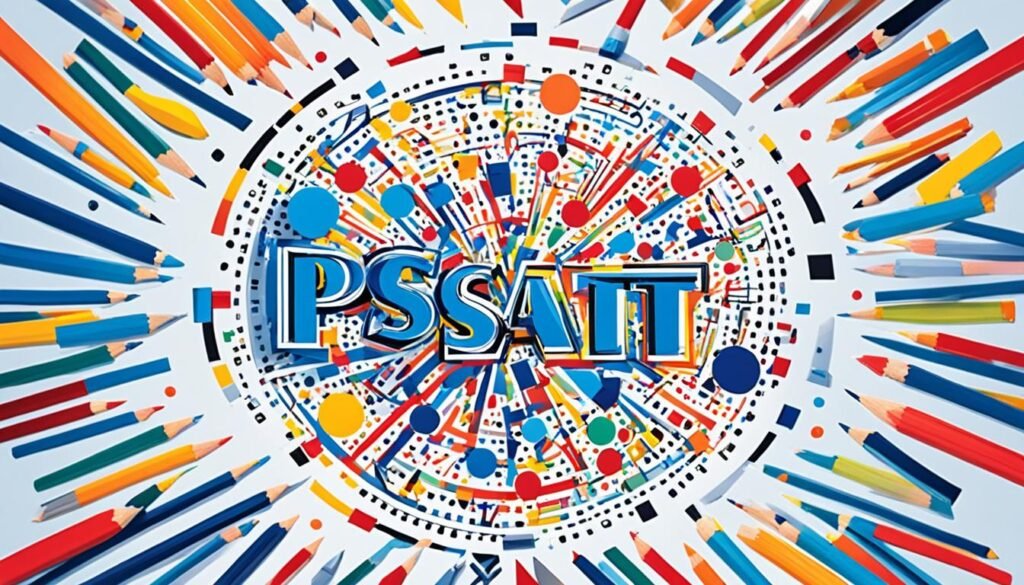
The PSAT/NMSQT is important for the National Merit Scholarship Program. If you do well on this test in 11th grade, you might get a scholarship. This could be a big help for your college costs.
Selection Process for National Merit Scholarships
Getting a National Merit Scholarship is tough. Top 1% scorers become National Merit Semifinalists. Then, they must meet more goals to be a National Merit Finalist.
Types of National Merit Scholarships
As a Finalist, you can win different kinds of scholarships:
- National Merit Scholarships – Chosen by the Scholarship Corporation.
- Corporate-sponsored Scholarships – From big companies for Finalists meeting their needs.
- College-sponsored Scholarships – Offered by colleges the Finalists choose to attend.
These scholarships are a big help for college-bound students and their families. They offer strong financial support.
Also Read: What Is The NYSTCE Exam And How Do I Prepare For It?
College Readiness Evaluation
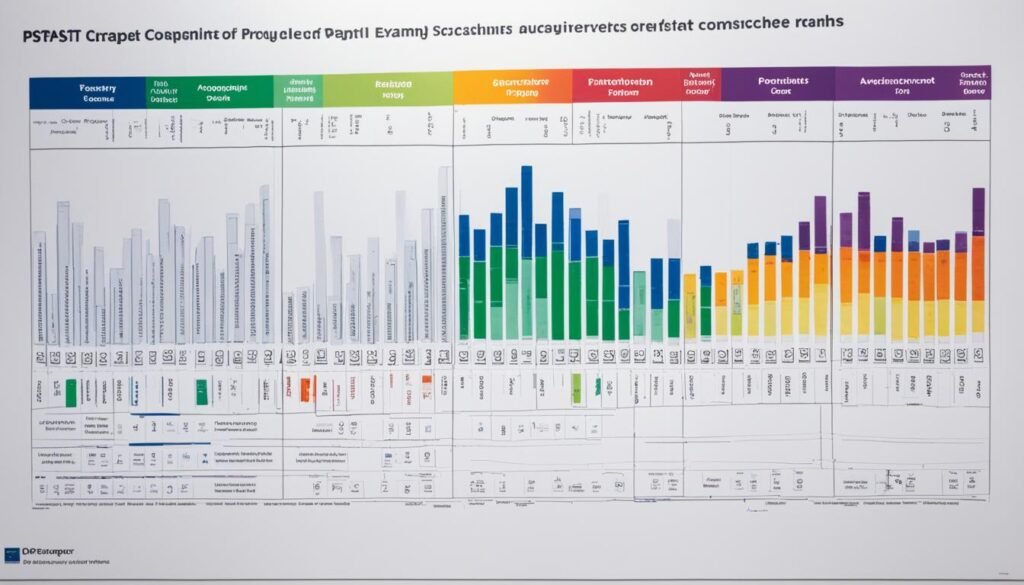
The PSAT is important for seeing if you’re ready for college. It comes in different forms – PSAT 8/9, PSAT 10, and PSAT/NMSQT. Each has its own scores and goals set by the College Board.
PSAT Score Ranges and Benchmarks
These PSAT score ranges show how well you do in school. They match up with the SAT, making it easy to see how you’re doing. The College Board also set benchmarks to help figure out if you’re ready for college classes.
| PSAT Version | Score Range | College Readiness Benchmark |
|---|---|---|
| PSAT 8/9 | 320-1440 | 430 in Reading and Writing, 480 in Math |
| PSAT 10 | 320-1520 | 460 in Reading and Writing, 510 in Math |
| PSAT/NMSQT | 320-1520 | 460 in Reading and Writing, 510 in Math |
Identifying Academic Strengths and Weaknesses
The PSAT also shows where you’re doing well or need to improve. After taking the test, you get a report that breaks down your scores. This feedback helps you know what to focus on.
Knowing your PSAT scores can help with college and getting scholarships. It means you can plan how to do better next time and be more ready for college.
Also Read: What Are The Key Components Of The Duolingo Exam English Test?
PSAT Exam Format and Content
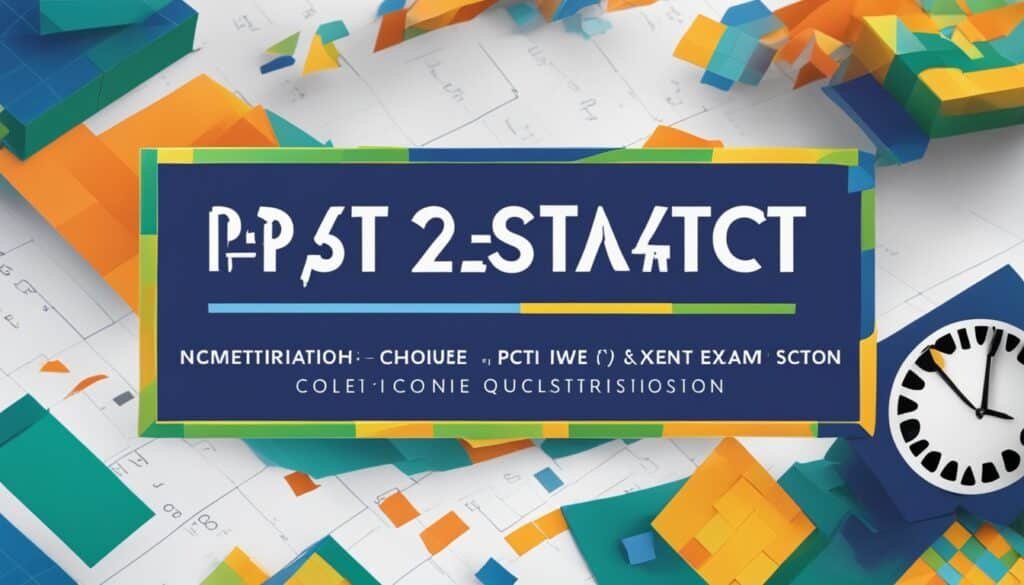
The PSAT exam is a lot like the SAT, with two big parts: Evidence-Based Reading and Writing, and Math. Both parts have smaller sections that look at different academic skills. These include critical thinking, and analytical reasoning. There’s also English language arts, and mathematics.
Test Sections and Question Types
In the Evidence-Based Reading and Writing area, there’s Reading and Writing and Language. The Reading part checks if students can understand and think deeply about what they read. The Writing and Language part looks at how well they use English language rules and express themselves.
The Math section is split into Calculator and No Calculator parts. It leaks mathematical reasoning, problem-solving, and how you apply mathematical concepts.
Timing and Scoring
| PSAT Section | Time Allotted | Number of Questions |
|---|---|---|
| Evidence-Based Reading and Writing | 60 minutes | 47-67 |
| Math | 70 minutes | 48-58 |
The PSAT’s scores go from 320 to 1520. You get a section score for Evidence-Based Reading and Writing and Math. These range from 160 to 760. Your total score is the sum of these. The scoring system is the same as the SAT, making comparing scores easy.
Preparing for the PSAT

Getting ready for the PSAT is a key step to do well. It shares a lot in common with the SAT. This means study resources and strategies overlap, making preparation easier.
PSAT Study Resources and Materials
There are many PSAT study guides, practice tests, and materials out there. Places like the College Board offer them. These resources help with critical reading, writing, math, and more. They help you understand the test and sharpen your academic and test-taking skills.
Practice Tests and Study Strategies
Doing PSAT practice tests show where you shine and where you need more work. Besides tests, good study strategies are important. This includes managing time, critical thinking, and problem-solving. They prep you not just for the PSAT but for college too.
| PSAT Prep Resources | Description |
|---|---|
| Official PSAT/NMSQT Study Guide | Comprehensive guide from the College Board with practice questions, test-taking tips, and scoring information. |
| PSAT Practice Tests | Full-length practice exams that mimic the actual PSAT format and content. |
| Khan Academy PSAT Prep | Free, personalized PSAT preparation with interactive lessons, practice questions, and performance tracking. |
| Test Prep Books | Commercially published PSAT study guides with practice questions, strategies, and content reviews. |
PSAT Test Dates and Registration
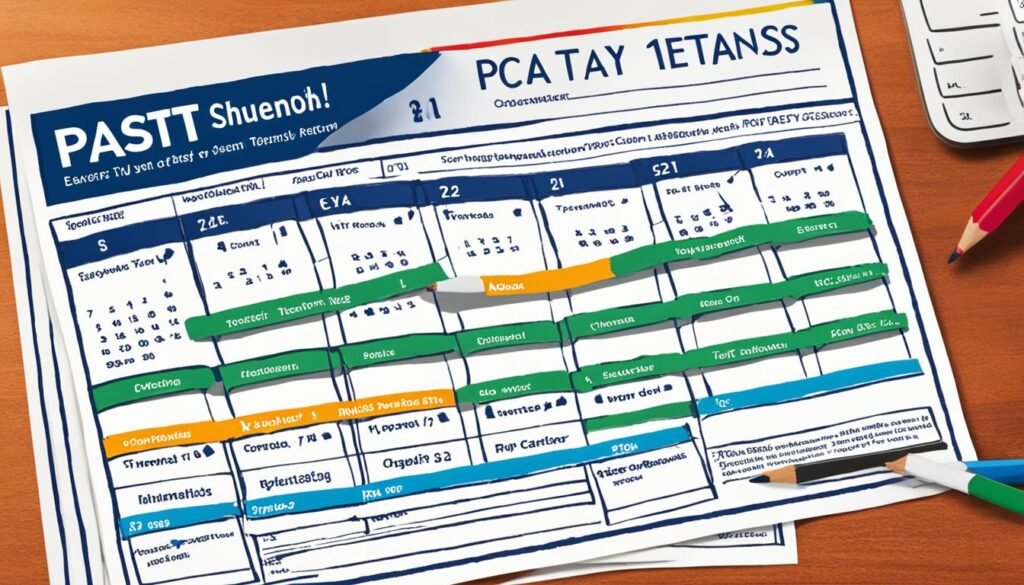
The PSAT exam takes place on different dates, depending on the test version. The PSAT 8/9 happens in both fall and spring for high school assessments. Yet, the PSAT 10 and PSAT/NMSQT are set on specific test administration dates.
Students take the PSAT 8/9 in October or March. PSAT test dates change depending on the district and state. The PSAT 10 is given in February or April. For the PSAT/NMSQT, used for the National Merit Scholarship, it’s in October.
Students need to contact their school counselor or the College Board to sign up for the psat registration. Registration opens several months before the test. It’s key to keep an eye on deadlines to join this standardized testing and vital academic milestones.
| PSAT Version | Test Dates | Registration Deadlines |
|---|---|---|
| PSAT 8/9 | Fall and Spring testing windows | Varies by school district and state |
| PSAT 10 | February or April | Several months before test date |
| PSAT/NMSQT | October | Several months before test date |
Understanding the psat test dates and psat registration helps students get ready. It’s important to be prepared for the PSAT. Doing so brings benefits, like knowing readiness for college, scholarships, and learning about strengths and areas for improvement.
Interpreting PSAT Scores
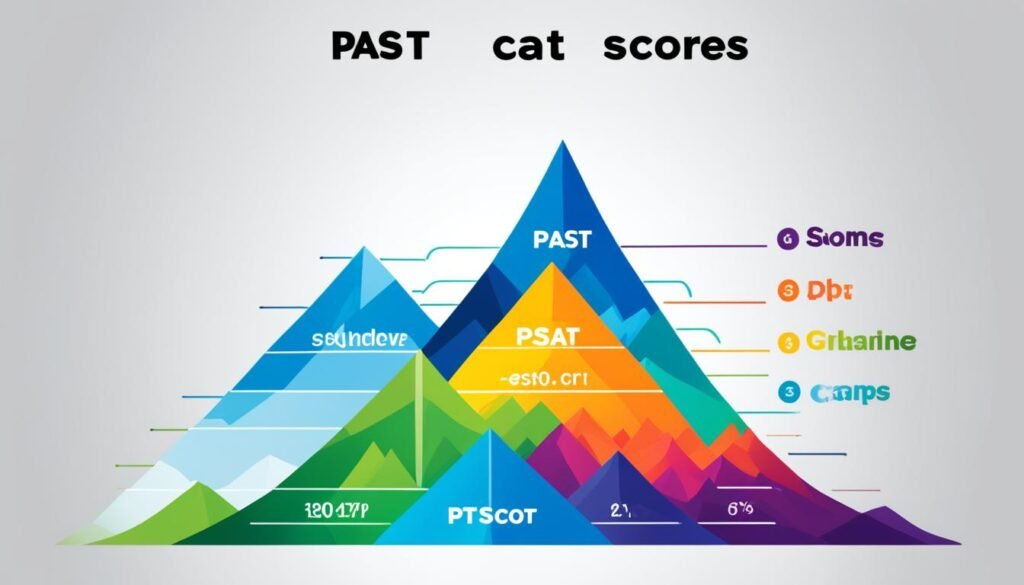
Understanding PSAT scores is key for students to see how they’re doing in school. And also to know if they’re ready for college. Each PSAT score report shows how a student did. It includes the scores from each part, the total score, and what these scores mean.
Understanding Score Reports
The PSAT score report gives a detailed look at a student’s performance. It shows their total score, made up of Evidence-Based Reading and Writing and Math scores. Plus, there’s info on how the student’s scores match up to college readiness benchmarks from the College Board.
Determining College Readiness
This report also indicates the student’s college readiness based on their scores. It shows if they’re prepared for the challenges of college. And it helps point out areas where they might need to work harder. This feedback aids both students and teachers in setting goals and improving standardized test performance.
PSAT Exam and SAT Relationship

The PSAT and SAT exams are a lot alike. Both use the same score scale and format. They are designed so that the PSAT is like a preview of the SAT. Students’ performance on both tests can be directly compared because of this.
Common Score Scale and Concordance
The PSAT and SAT share a common score scale. This means that scores from both tests can be easily understood and compared. Teachers and students use this scale to see how ready a student is for college, no matter which test they took.
PSAT as SAT Practice
When students take the PSAT, they’re practicing for the SAT. Both tests have a similar look and ask similar things. This means students can use what they’ve learned from the PSAT to do better on the SAT. It’s a great way to get ready for college and feel more confident about the SAT.
Benefits of Taking the PSAT

By taking the PSAT, students open doors to many opportunities. These can shape their future in academics and work. The test helps students in many ways, from scholarships to planning for college and careers.
Scholarship Opportunities
The PSAT can lead to winning National Merit Scholarships. If you do well in the junior year’s PSAT/NMSQT, you might become a National Merit Semifinalist or Finalist. This status can win you merit-based scholarships, lightening the financial load of college.
College and Career Planning
It’s not just about money; the PSAT aids in college planning and exploring future jobs. The test tells students what they’re good at and where they need to work harder. This info helps shape their path toward college and career goals. It also sets the stage for SAT success.
Academic Skill Assessment
The PSAT allows for checking academic skills and test performance without too much pressure. Students find out their strong and weak points in reading, math, and writing. Then, they can prep better, using focused study strategies. This sets them up to ace the SAT later.
The PSAT gives students so many educational opportunities. It can lead to doing well in school, getting important scholarship funds, and choosing the right college and career paths.
Myths and Facts About the PSAT

The PSAT, or Preliminary Scholastic Aptitude Test, is key for high schoolers getting ready for college. But there’s a lot of confusion around it. It’s important to know what’s true and what’s not about the PSAT.
Some say the PSAT is just a warm-up for the SAT. While the tests are similar, there’s much more to the PSAT. It helps to see how ready you are for college and might lead to scholarships, like the National Merit Scholarship. This makes it more than just practice.
Others believe only top students should take the PSAT. In fact, it can help any student. It shows what you’re good at and where you need improvement, which can boost your test and general school skills.
A big myth is that the PSAT is a must-do. While your school might push you to take it, it’s not required. Still, the PSAT offers many perks, making it a smart choice for all high school students.
So, it’s essential to understand the facts about the PSAT. By knowing its real purpose and advantages, students can get ready for college more effectively. This makes the PSAT a significant step on the education path.
Also Read: Cracking DCAS Exams: Are You Ready?
Conclusion
The PSAT is key for high schoolers getting ready for college in the U.S. Taking the PSAT helps students check how well they’re doing in school. It shows what they’re good at and what they need to work on. This makes it easier to get ready for the SAT.
By taking the PSAT, students can win a chance at the National Merit Scholarship. This is a big deal because it offers a lot of money for college. Also, the PSAT is a lot like the SAT. So, by practicing, students can get better at taking tests.
The PSAT is more than just a test. It’s a step that helps students own their school journey. It shows them where they shine. And it gets them ready for a future full of learning and job chances. Thanks to the PSAT, students can feel sure as they plan for college and work life.
FAQs
What is the PSAT exam?
The PSAT is a test that checks your critical reading, math, and writing abilities. It’s a practice for the SAT exam. By taking the PSAT, students may be able to get National Merit Scholarships.
What are the different forms of the PSAT?
There are three versions of the PSAT. The PSAT 8/9 is for 8th and 9th graders. Then there’s the PSAT 10 for 10th graders. Finally, the PSAT/NMSQT is for juniors and is also the National Merit Scholarship Qualifying Test.
What is the purpose and importance of the PSAT?
The PSAT helps students see if they’re ready for college. It lets them see their strong and weak points. This way, they can get ready for the SAT.
What is the National Merit Scholarship Qualifying Test?
The PSAT/NMSQT is a big part of the National Merit Scholarship Program. If students do well on it as juniors, they might get National Merit Scholarships.
How are PSAT scores interpreted?
Your PSAT score report shows your scores in different areas. It helps you see how ready you are for college.
What is the format and content of the PSAT exam?
The PSAT is a lot like the SAT. It has two main parts: Reading and Writing, and Math. Both parts have smaller sections that test different skills.
How can students prepare for the PSAT?
Preparing for the PSAT means studying hard. Use practice tests and good study methods. These are the same things you’d do to study for the SAT.
When and how do students register for the PSAT?
There are different test dates for the PSAT, depending on which you take. The PSAT 8/9 can be taken during the school year. For the PSAT 10 and PSAT/NMSQT, there are set dates. Students sign up for the PSAT through their school.
How are PSAT scores related to the SAT?
The PSAT and SAT use the same score scale. This lets you compare your scores on both tests. The PSAT is like a practice for the SAT.
What are the benefits of taking the PSAT?
There are many good reasons to take the PSAT. It can help you get scholarships, plan for college and careers, and understand your academic skills better.
Are there any myths or misconceptions about the PSAT?
Some people have the wrong idea about the PSAT. It’s important for students and parents to learn the truth about it. This helps you see its real value.
Source Links
- https://www.princetonreview.com/college-advice/why-take-the-psat
- https://satsuite.collegeboard.org/sat-suite-benefits-schools-districts/why-offer-psat-nmsqt
- https://www.usnews.com/education/best-colleges/articles/what-the-psat-is-and-what-to-know-about-the-exam





